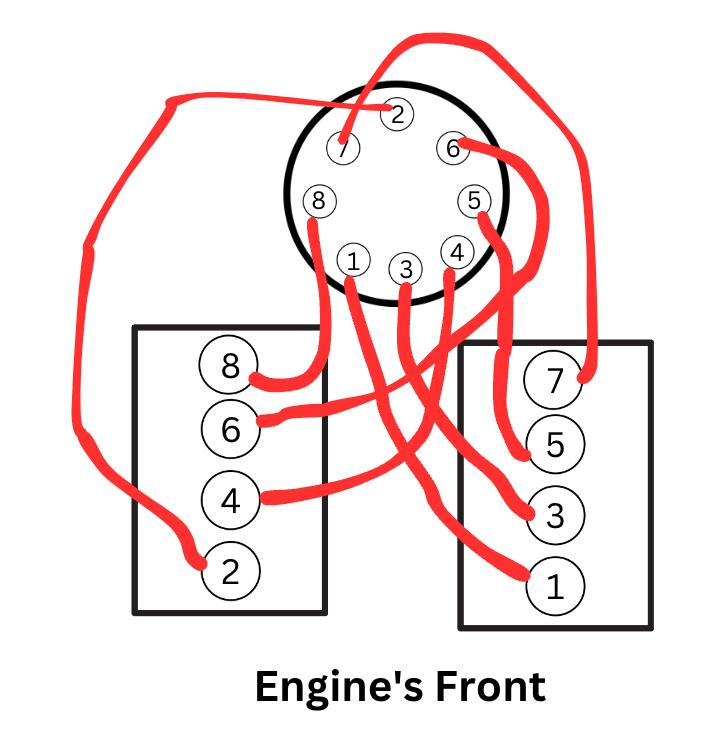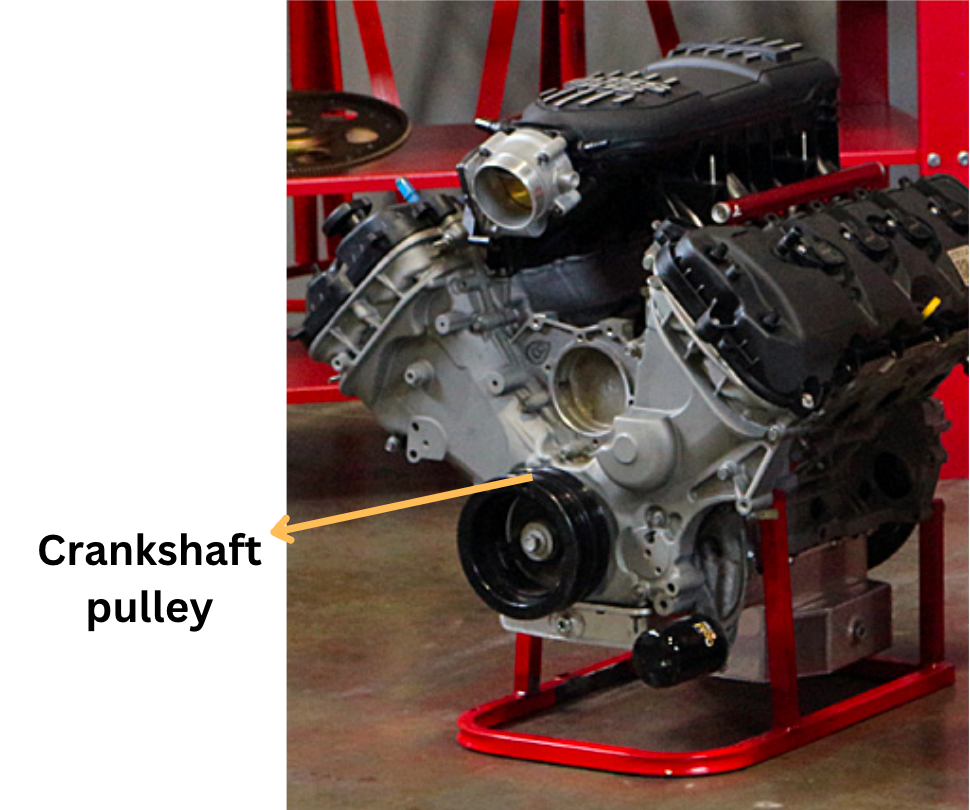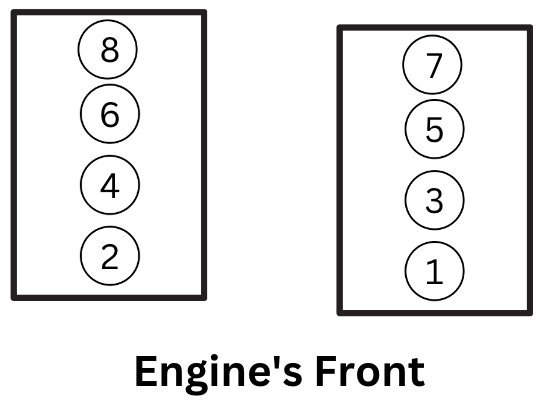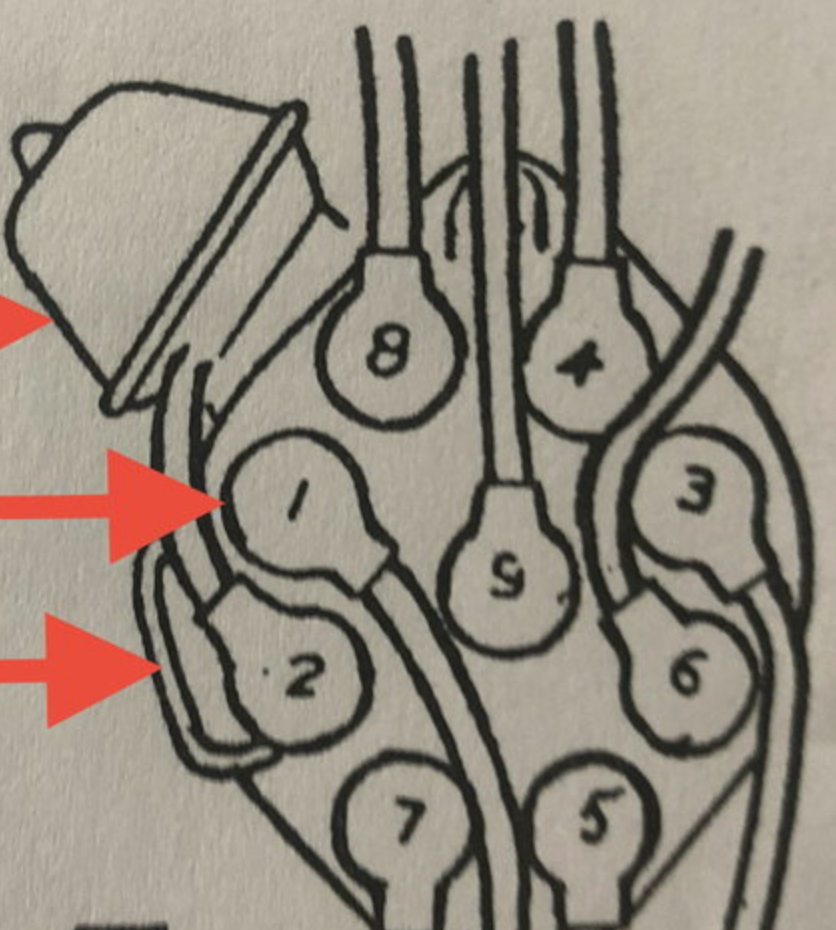Chevy 5.3 Firing Order and Sequence
Having engine issues in your Chevy truck? The firing order and sequence are key to smooth performance. From misfires to loss of power, an incorrect order can cause frustration. In this guide, we’ll break down the Chevy 5.3 firing order in simple terms to help you get your truck back on the road.
You can also read my guide on common problems with Chevy 305.
5.3L Chevy Firing Sequence
The Chevy 5.3 Firing Order is 1-8-7-2-6-5-4-3. This specifies the sequence in which the spark plugs fire in the V8, 5.3L engine.
The first spark plug to fire is cylinder 1, located at the front of the engine block. The firing then proceeds clockwise to cylinder 8, followed by 7, 2, 6, 5, 4, and finally 3 to complete the sequence.
This clockwise firing order is crucial for the proper timing of the spark plugs and fuel injectors. An incorrect order will prevent smooth running and cause misfires.

The red lines in the diagram show the path of the spark plug wires from the distributor to each cylinder.
Note the wire for cylinder 1 position may vary by model. The diagram is just a visual representation, not exact layout.
To confirm the clockwise rotation of the distributor in a 5.3L Chevy:
- Locate the distributor cap at the front of the engine block.
- Observe the metal distributor rotor under the cap that connects the coil to the plug wires.
- With idling engine, watch the rotor’s direction of spin.
- Clockwise distributor rotation confirms the Chevy 5.3L’s design.
What Exactly Does Clockwise and Anticlockwise Mean In Firing Orders?
If the cylinders turn clockwise, they fire in a clockwise sequence when you look at the front of the engine. If the cylinders turn counterclockwise, they fire in a counterclockwise sequence from the front.
You don’t need to worry about which way the cylinders rotate. The engineers decide this when they design the engine. Do not try to change the rotation unless you have a special reason.
To see which way the engine rotates, stand at the front of the engine while it is running. Watch the crankshaft pulley in the middle. If the pulley turns clockwise, the engine rotates clockwise. If the pulley turns counterclockwise, the engine rotates counterclockwise.

How to Determine Cylinder Numbering In Chevy 5.3 Engine?

The Chevy 5.3 engine has eight cylinders in a V shape. The cylinders on the driver’s side are numbered 1, 3, 5, and 7. The cylinders on the passenger side are 2, 4, 6, and 8.
Cylinder number 1 in the Chevy 5.3 is on the driver’s side closest to the front of the vehicle. The numbers go in order with cylinder 3 next to cylinder 1, cylinder 5 next to 3, and so on.
The front of the Chevy 5.3 engine faces the crankshaft pulley. If you stand in front of your Chevy, that is the engine’s front.
Knowing the cylinder numbers helps find problems. If one cylinder misfires or causes issues, you can use a code reader. It will show which cylinder has the problem.
For example, if the code reader shows a P0304 error in a Chevy 5.3, you know cylinder 4 is misfiring. Then you can fix it.
How Does Chevy 5.3 Firing Sequence Relate With Top Dead Center?
The crankshaft turns and makes the pistons go up and down in the cylinders. When a piston gets to the top dead center (TDC), this is the highest point it can reach.
At TDC, the spark plug fires and causes a mini-explosion that pushes the piston back down. This makes the power to move your vehicle forward.
If all the pistons reached TDC together, it would mess things up. So let’s see how the firing order for a Chevy 5.3 relates to the piston at TDC.
The number 1 cylinder is first in the firing order. It’s on the driver’s side. When it’s at TDC on compression, the crankshaft position sensor tells the engine control module to start the spark plugs firing. The order goes clockwise from there.
What does clockwise mean for firing order? It’s the sequence the cylinders fire in when viewed from the front or looking at the distributor cap if there is one.
So after cylinder 1 fires, the next is number 8 clockwise from 1. It keeps going in clockwise order with each one firing next in line.
Why Sequence Of Chevy 5.3 Firing Order Is Important and What Will Happen If the Spark Plug Wire for Cylinder 1 Is At a Different Location In the Distributor?

The spark plug wire for cylinder 1 must be in the correct place. If it’s not, the firing order is wrong. This can make the engine run rough or even stall.
The 5.3 Chevy engine needs the cylinder 1 spark plug wire to be in the right spot in the distributor. If it’s somewhere else, the firing order is off. The engine won’t run right.
Think about it like this. If you put the cylinder 1 wire where cylinder 8 goes in the distributor cap, cylinder 1 won’t fire when it should. This throws off the timing. The engine will shake a lot and run bad.
The firing order matters for some big reasons:
- Smoother engine. The right order balances the power from the pistons. This makes the engine run more smoothly. It’s more comfortable to drive.
- Less wear and tear. The order spreads out the force evenly inside the engine. This puts less stress on engine parts. That means the engine lasts longer.
- Better performance. The wrong firing order can cause misfires. This makes the engine run rough. The right order prevents misfires and makes the engine run smoothly.
- Torque management. Firing in the correct sequence manages torque efficiently. More torque equals better engine power. The wrong order reduces torque.
The right firing order improves combustion. That boosts torque and power. It also reduces vibration for smooth operation. Ultimately, the correct firing order means better engine performance and a better driving experience.
Due to the above reasons, GM decided to change the firing sequence of its v8 engines to 1-8-7-2-6-5-4-3 (4-7/2-3 swap) in its small block LS engines.
How To Determine Spark Plug Wire Position For Cylinder One In Distributor Chevy?
Determining the number one cylinder’s spark plug wire position on the distributor requires rotating the crankshaft by hand until the number one piston reaches top dead center (TDC).
Remove the corresponding spark plug and insert a piston stop tool to confirm when the piston hits TDC. Now observe which distributor terminal the rotor aligns with – this marks the plug wire position for cylinder one.
With the number one cylinder’s wire placement identified, an engine’s ignition timing can be verified using a timing light. This specialized tool connects to the ignition wires and flashes in sync with the sparking of each cylinder.
To use it, first attach the red lead to the battery’s positive terminal and the black to negative. Then clip the sensor to the number one spark plug wire.
After starting the engine, aim the timing light at the timing pointer marks. The strobe-like flashing visualizes when the number one piston reaches TDC.
Adjusting ignition timing on clockwise-rotating distributors involves:
- Advancing timing – carefully rotate distributor counterclockwise to the desired timing mark.
- Retarding timing – rotate distributor clockwise, same direction as normal operation.
To learn more, I would highly recommend watching the complete video I have linked below. It proved to be really helpful for me.
Can You Change Firing Order of Chevy 3.5?
Firing order affects the engine’s overall balance and vibration characteristics. While it is theoretically possible to change the firing order on many V8s, doing so improperly can create performance issues or even catastrophic engine damage over time.
